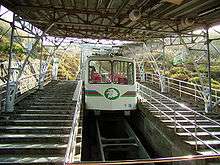Tōkaidō Shinkansen
| Tōkaidō Shinkansen | |||
|---|---|---|---|
|
| |||
 A JR West N700 series train passing Maibara Station on the Tokaido Shinkansen in January 2011 | |||
| Overview | |||
| Native name | 東海道新幹線 | ||
| Type | Shinkansen | ||
| Locale | Tokyo; Kanagawa, Shizuoka, Aichi, Gifu, Shiga, Kyoto, and Osaka Prefectures | ||
| Termini |
Tokyo Shin-Osaka | ||
| Stations | 17 | ||
| Operation | |||
| Opened | 1 October 1964 | ||
| Owner | JR Central | ||
| Operator(s) |
JR Central JR West | ||
| Depot(s) | Tokyo, Mishima, Nagoya, Osaka | ||
| Rolling stock |
700 series N700 series | ||
| Technical | |||
| Line length | 515.4 km (320.3 mi) | ||
| Track gauge | 1,435 mm (4 ft 8 1⁄2 in) | ||
| Electrification | 25 kV AC, 60 Hz, overhead catenary | ||
| Operating speed | 285 km/h (175 mph) | ||
| |||
The Tōkaidō Shinkansen (東海道新幹線) is a Japanese high-speed Shinkansen line, opened in 1964 between Tokyo and Shin-Ōsaka. Since 1987 it has been operated by the Central Japan Railway Company (JR Central), prior to that by Japanese National Railways (JNR). It is the most heavily travelled high-speed rail route in the world by far; its cumulative ridership of 5.3 billion passengers dwarfs all other lines worldwide.[1][2]
The line was named a joint Historic Mechanical Engineering Landmark and IEEE Milestone by the American Society of Mechanical Engineers and the Institute of Electrical and Electronics Engineers in 2000.[3][4]
Train services
| Tōkaidō Shinkansen | |||||||||||||||||||||||||||||||||||||||||||||||||||||||||||||||||||||||||||||||||||||||||||||||||||||||||||||||||||||||||||||||||||||||||||||
|---|---|---|---|---|---|---|---|---|---|---|---|---|---|---|---|---|---|---|---|---|---|---|---|---|---|---|---|---|---|---|---|---|---|---|---|---|---|---|---|---|---|---|---|---|---|---|---|---|---|---|---|---|---|---|---|---|---|---|---|---|---|---|---|---|---|---|---|---|---|---|---|---|---|---|---|---|---|---|---|---|---|---|---|---|---|---|---|---|---|---|---|---|---|---|---|---|---|---|---|---|---|---|---|---|---|---|---|---|---|---|---|---|---|---|---|---|---|---|---|---|---|---|---|---|---|---|---|---|---|---|---|---|---|---|---|---|---|---|---|---|---|
| |||||||||||||||||||||||||||||||||||||||||||||||||||||||||||||||||||||||||||||||||||||||||||||||||||||||||||||||||||||||||||||||||||||||||||||
|
Times shown are fastest timetabled journey from Tokyo. | |||||||||||||||||||||||||||||||||||||||||||||||||||||||||||||||||||||||||||||||||||||||||||||||||||||||||||||||||||||||||||||||||||||||||||||

- Nozomi: limited-stop services, since March 1992
- Hikari: semi-fast services
- Kodama: all-stations shuttle services
There are three types of trains on the line: from fastest to slowest, they are the Nozomi, Hikari, and Kodama. Many Nozomi and Hikari trains continue onward to the San'yō Shinkansen, going as far as Fukuoka's Hakata Station.
700 series and N700 series train sets operate on the line in any of the three service patterns. The Hikari run from Tokyo to Osaka took four hours in 1964; this was shortened to 3 hours 10 minutes in 1965. With the introduction of high-speed Nozomi service in 1992, the travel time was shortened to 2 hours 30 minutes. The introduction of N700 series trains in 2007 further reduced the Nozomi travel time to 2 hours 25 minutes. As of 14 March 2015, after a speed increase to 285 km/h (177 mph), the fastest Nozomi service now takes 2 hours 22 minutes from Tokyo to Shin-Osaka.
As of August 2008, Hikari services travel from Tokyo to Shin-Osaka in approximately 3 hours, with all-stopping Kodama services making the same run in about 4 hours.
Nozomi trains cannot be used by tourists using the Japan Rail Pass.[5]
Stations
Kodama trains stop at all stations. Nozomi and Hikari trains have varying stopping patterns (some Hikari trains stop at stations marked "▲"). All trains stop at Tokyo, Shinagawa, Shin-Yokohama, Nagoya, Kyoto, and Shin-Osaka.
Rolling stock
- 700 series 16-car sets, since March 1999 (owned by JR Central and JR West)
- N700A series 16-car sets, since 1 July 2007 (owned by JR Central and JR West, modified from original N700 series sets)
- N700A series 16-car sets, since 8 February 2013 (owned by JR Central and JR West)
- N700S 16-car sets, to be introduced by JR Central from fiscal 2020[6]
All Tokaido Shinkansen services are scheduled to be operated by N700A series or N700A series trainsets by the end of fiscal 2019.[7]
 JR Central 700 series
JR Central 700 series JR Central N700 series
JR Central N700 series
Past rolling stock
- 0 series 12/16-car sets, 1 October 1964 to 18 September 1999 (owned by JR Central and JR West)
- 100 series 16-car sets, 1 October 1985 to September 2003 (owned by JR Central and JR West)
- 300 series 16-car sets, March 1992 to March 16, 2012 (owned by JR Central and JR West)
- 500 series 16-car sets, November 1997 to February 2010 (owned by JR West)
 0 series, May 1967
0 series, May 1967- JR Central 100 series, May 2003
- JR Central 300 series, February 2011
 500 series, May 2008
500 series, May 2008
Timeline
Rolling stock transitions
History

The Tokaido Shinkansen line was originally conceived in 1940 as a 150 km/h (93 mph) dedicated railway between Tokyo and Shimonoseki, which would have been 50% faster than the fastest express train of the time. The beginning of World War II stalled the project in its early planning stages, although a few tunnels were dug that were later used in the Shinkansen route.
Construction of the line began on 20 April 1959 under JNR president Shinji Sogō and chief engineer Hideo Shima. It was completed in 1964, with the first train travelling from Tokyo to Shin-Osaka on 1 October 1964 at 210 km/h (130 mph). The opening was timed to coincide with the 1964 Summer Olympics in Tokyo, which had already brought international attention to the country. Originally, the line was called the New Tokaido Line in English. It is named after the Tokaido route of Japan, used for centuries. Speeds have been increased to 285 km/h (177 mph), except for lower limits applying between Tokyo and Shin-Yokohama and in densely populated urban areas around Nagoya, Kyoto and Shin-Osaka stations.[8]
A new Shinkansen stop at Shinagawa Station opened in October 2003, accompanied by a major timetable change which increased the number of daily Nozomi services.
All Tōkaidō Shinkansen trains to and from Tokyo make station stops at Shinagawa and Shin-Yokohama. (Before March 2008, alternating Nozomi and Hikari services stopped at either or both of these stations.)
A new station, Minami-Biwako, was planned to open in 2012 between Maibara and Kyoto to allow a transfer to the Kusatsu Line. Construction started in May 2006, but in September 2006, the Ōtsu district court ruled that the ¥4.35 billion bond that Rittō city had issued to fund construction was illegal under the local finance law and had to be cancelled. The project was officially cancelled in October 2007.[9]
Ridership
From 1964 to 2012, the Tokaido Shinkansen line alone carried some 5.3 billion passengers,[2] making it by far the most heavily used HSR line in the world. Ridership increased from 61,000 per day in 1964[10] to 391,000 per day in 2012.[2]
| Year | 1967 | 1976 | 2004 | Mar 2007 | Nov 2010 | 2012 |
|---|---|---|---|---|---|---|
| Ridership (Cumulative) | 100 | 1,000 | 4,160[11] | 4,500[12] | 4,900[1] | 5,300[2] |
| Year | 1967 | April 1987 | April 2007 | April 2008 | April 2009 | April 2010 | April 2011 | April 2012 |
|---|---|---|---|---|---|---|---|---|
| Ridership | 22[10] | 102[10] | 151[10] | 149[10] | 138[10] | 141[10] | 149[10] | 143[2] |
Future developments
It was announced in June 2010 that a new shinkansen station in Samukawa, Kanagawa Prefecture was under consideration by JR Central. If constructed, the station would open after the new maglev service begins operations.[13]
In December 2013, JR Central president Yoshiomi Yamada announced the operating company's intentions to raise the maximum line speed beyond 270 km/h (170 mph), with a revised timetable to be introduced in spring 2015.[14] In February 2014, JR Central announced that, from spring 2015, the maximum speed would be increased to 285 km/h (177 mph) for services using N700A or modified N700 series trains.[15] Initially, just one service per hour will run at 285 km/h (177 mph), with more services gradually added later.[15]
References
- 1 2 "Bullet Train & Maglev System to Cross the Pacific" Archived 24 July 2012 at the Wayback Machine., Saturday, 4 September 2010 09:55, by Yoshiyuki Kasai, Chairman of JR-C
- 1 2 3 4 5 Central Japan Railway Company Annual Report 2012. Retrieved 3 June 2013].
- ↑ "Tokaido Shinkansen (1964)". Landmarks. American Society of Mechanical Engineers. Retrieved 3 June 2013.
- ↑ "Milestones:Tokaido Shinkansen (Bullet Train), 1964". IEEE Global History Network. IEEE. Retrieved 4 August 2011.
- ↑ http://www.japanrailpass.net/eng/en004.html http://japanrailpass.net JAPAN RAIL PASS validity
- ↑ JR東海 次期新幹線はN700S 2018年導入 [JR Central to introduced next-generation N700S shinkansen in 2018]. Mainichi Shimbun (in Japanese). Japan: The Mainichi Newspapers. 24 June 2016. Archived from the original on 24 June 2016. Retrieved 25 June 2016.
- ↑ N700Aの追加投入について 全ての東海道新幹線が「N700Aタイプ」になります [Details of additional N700A introductions - All Tokaido Shinkansen services to become N700A type] (pdf). News release (in Japanese). Japan: Central Japan Railway Company. 22 October 2015. Retrieved 22 October 2015.
- ↑ "300km/hのトップランナー" [300 km/h Top Runners]. Japan Railfan Magazine. Vol. 52 no. 612. Japan: Koyusha Co., Ltd. April 2012. p. 14.
- ↑ "Shinkansen station in Shiga canceled". The Japan Times. 29 October 2007. Retrieved 3 June 2013.
- 1 2 3 4 5 6 7 8 Central Japan Railway Company Annual Report 2011. Retrieved 3 June 2013.
- ↑ http://www.japantimes.co.jp/news/2004/10/02/business/tokaido-shinkansen-line-fetes-40-years/#.Ua0NG0DVDzw Japan Times Tokaido Shinkansen Line fetes 40 years Saturday, 2 October 2004
- ↑ Central Japan Railway Company Annual Report 2007. Retrieved on 28 April 2009.
- ↑ "New Shinkansen station considered for Kanagawa". Japan Today. 7 June 2010. Retrieved 15 June 2010.
- ↑ JR東海、東海道新幹線を高速化=15年春にも-山田社長 [JR Central to increase Tokaido Shinkansen speed from spring 2015]. Jiji.com (in Japanese). Japan: Jiji Press Ltd. 19 December 2013. Archived from the original on 20 December 2013. Retrieved 20 December 2013.
- 1 2 東海道新幹線の速度向上について [Tokaido Shinkansen speed increase]. News release (in Japanese). Japan: Central Japan Railway Company. 27 February 2014. Retrieved 27 February 2014.
External links
| Wikimedia Commons has media related to Tōkaidō Shinkansen. |



